Auckland volcanic field
| Auckland Volcanic Field | |
|---|---|
relationships to other North Island surface volcanism
| |
| Geology | |
Ma[1] | |
| Mountain type | Volcanic field |
| Type of rock | Basalt |
| Last eruption | c. 1400 CE |
The Auckland volcanic field is an area of
Features
The field ranges from
The first vent erupted at
Lake Pupuke, on the North Shore near Takapuna, is a volcanic explosion crater. A few similar craters such as Ōrākei Basin are open to the sea.
The field has produced voluminous lava flows that cover much of the
For most of the 200,000 years that the field has been erupting, the planet has been in glacial periods (ice ages) where sea levels were much lower due to water being locked up as ice, and the Waitemata and Manukau Harbours were dry land. All the volcanoes probably erupted on land except for Rangitoto, which erupted during the current interglacial (warmer) period.[17]
Tectonic relationships

The Auckland region lies within the Australian Plate, about 400 kilometres (250 mi) west of its plate boundary with the Pacific Plate.[18] The volcanoes are located south of a geological region called the Northland Allochthon, and with the northern volcanoes located over early Miocene sedimentary deposits of the Waitematā Group of rocks and the southern volcanoes over post Miocene sediments.[18] A large proportion of the volcanoes in the field, particularly those with cone structures, lie within 500 metres (1,600 ft) of inferred or known faults, with the qualification that these are inactive historic faults and unlike in many other volcanic fields it is rare for volcanoes to be actually on the fault line.[19] The structure of these Auckland regional faults and the resulting fault blocks is complex but like the volcanic field their locations can be postulated to be related to gravitational variations and where the Stokes Magnetic Anomaly passes through this section of the North Island.[18] The field is part of the Auckland Volcanic Province which comprises four volcanic fields with intra-plate basaltic volcanism starting in the south, at Okete, near Raglan in late Pliocene times (2.7-1.8 Ma).[20] Activity has since moved north through the Ngatutura, South Auckland and Auckland fields since then.[21]
Human context
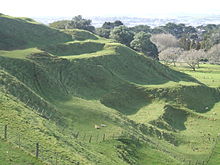
Mythology
Tāmaki Māori myths describe the creation of the volcanic field as a creation of Mataaho (the guardian of the earth's secrets) and his brother Rūaumoko (the god of earthquakes and volcanoes), made as punishment against a tribe of patupaiarehe, supernatural beings living in the Waitākere Ranges, who used deadly magic from the earth to defeat a war party of patupaiarehe from the Hunua Ranges.[22][23] In some traditions, the fire goddess Mahuika creates the volcanic field as a way to warm Mataaho, after his wife leaves and takes his clothing.[24][25] Because of their close association to Mataaho, the volcanic features can be collectively referred to as Nga Maunga a Mataaho ("The Mountains of Mataaho"),[22] or Ngā Huinga-a-Mataaho ("the gathered volcanoes of Mataaho").[25] Many of the volcanic features of Māngere can be referred to as Nga Tapuwae a Mataoho ("The Sacred Footprints of Mataoho"), including Māngere Lagoon, Waitomokia, Crater Hill, Kohuora, Pukaki Lagoon and Robertson Hill.[24][26] Many of the Māori language names of volcanic features in the field refer to Mataaho by name, including Te Pane o Mataaho (Māngere Mountain), Te Tapuwae a Mataoho (Robertson Hill) and Te Kapua Kai o Mataoho (the crater of Maungawhau / Mount Eden).
Usage
Many of the maunga (mountains) were occupied by substantial Māori pā (fortifications) before Pākehā settlement, and many terraces and other archeological remnants are still visible.[27] Many of the cones have been levelled or strongly altered, in small part due to the historical Māori use, but mostly through relatively recent quarrying of construction materials (especially scoria). However many of the remaining volcanoes are now preserved as landmarks and parks.[8]
The warmer northern sides of the mountains were also popular among early
In March 2007, New Zealand submitted the volcanic field, with several specifically named features, as a World Heritage Site candidate based on its unique combination of natural and cultural features.[8] At that time, only 2 per cent of more than 800 World Heritage Sites worldwide were in this "mixed" category.
For most of Auckland's post-1840 history, the mountains have been administered variously by the New Zealand Crown, the Auckland Council (or its former bodies including the Auckland City Council and Manukau City Council) or the Department of Conservation.[27]
In the 2014
Dangers
Since the field is not extinct, new volcanic events may occur at any time, though the usual period between events is, on average, somewhere between hundreds to thousands of years. There has been at least one eruption in every 2,500 years over the last 50,000 years. It is possible that several volcanoes could erupt simultaneously. There is strong evidence that eight erupted within a span of 3000 years or so, between 31,000 and 28,000 years ago.
Most eruptive events in the field have been small volume, very constrained in time, typically involving less than 0.005 km3 (0.0012 cu mi) of magma making its way to the surface.
Various operative structures, plans and systems have been set up to prepare responses to volcanic activity within the urban areas, mainly coordinated in the Auckland Volcanic Field Contingency Plan[32] of the Auckland Regional Council, which provides a framework for interaction of civil defence and emergency services during an eruption. Auckland also has a seismic monitoring network comprising six seismometers—including one 250 metres (820 ft) deep at Riverhead—and three repeaters within the region that will detect the small tremors likely to precede any volcanic activity.[35] This is likely to give between a few hours and several days' warning of an impending eruption, and its approximate location.[31]
Auckland War Memorial Museum, itself built on the crater rim of Pukekawa, has an exhibition on the field, including the "Puia Street multi-sensory visitor experience", which simulates a grandstand view of an eruption in Auckland.[36]
List of volcanoes
The volcanoes within the field are:[5][37][38]
| Volcanoes | Age (thousand years)[39] | Height | Location ( Coordinates )
|
Refs | Images |
|---|---|---|---|---|---|
| Albert Park Volcano | 145.0 ± 4.0 | Unclear | 36°50′55″S 174°46′02″E / 36.8486°S 174.7673°E | [40] |  |
| Ash Hill | 31.8 ± 0.4 | 30 metres (98 ft) | 37°00′10″S 174°52′03″E / 37.002754°S 174.867545°E | ||
| Boggust Park Crater | 130+ | 14 metres (46 ft) | 36°57′19″S 174°48′49″E / 36.955413°S 174.813552°E | [2] |  |
| Cemetery Crater | Undated | 33 metres (108 ft) | 36°59′23″S 174°50′28″E / 36.989828°S 174.841082°E | [2] |  |
| Crater Hill | 30.4 ± 0.8 | 36°59′12″S 174°49′38″E / 36.986546°S 174.827135°E |   | ||
| Grafton Volcano | 106.5 | 82 metres (269 ft) | 36°51′30″S 174°45′49″E / 36.858440°S 174.763624°E |  | |
| Hampton Park | 57.0 ± 32.0 | 43 metres (141 ft) | 36°57′03″S 174°53′44″E / 36.950925°S 174.89544°E |  | |
| Kohuora | 33.7 ± 2.4 | 37 metres (121 ft) | 36°58′43″S 174°50′34″E / 36.97873°S 174.842691°E |  | |
| Māngere Lagoon | 59.5 | 20 metres (66 ft) | 36°57′25″S 174°46′39″E / 36.95702°S 174.77763°E |  | |
| Matanginui / Green Mount | 19.6 ± 6.6 | 78 metres (256 ft) | 36°56′24″S 174°53′54″E / 36.939911°S 174.898267°E |  | |
| Matukutūreia / McLaughlins Mountain | 48.0 ± 3.0 | 73 metres (240 ft) | 37°00′49″S 174°50′46″E / 37.013511°S 174.845974°E | [13] |  |
| Maungakiekie / One Tree Hill | 67.0 ± 12.0 | 182 metres (597 ft) | 36°54′0″S 174°46′59″E / 36.90000°S 174.78306°E |   | |
| Maungarahiri / Little Rangitoto | 24.6 ± 0.6 | 75 metres (246 ft) | 36°52′31″S 174°48′35″E / 36.875407°S 174.809636°E |  | |
| Maungarei / Mount Wellington | 10.0 ± 1.0 | 135 metres (443 ft) | 36°53′35″S 174°50′47.6″E / 36.89306°S 174.846556°E |   | |
| Maungataketake / Elletts Mountain | 88.9 ± 4.8 | 76 metres (249 ft) | 36°59′41″S 174°44′51″E / 36.994635°S 174.747548°E |  | |
Maungauika / North Head
|
87.5 ± 15.2 | 50 metres (160 ft) | 36°49′40″S 174°48′43″E / 36.827751°S 174.81205°E |   | |
| Maungawhau / Mount Eden | 28.0 ± 0.6 | 196 metres (643 ft) | 36°52′37″S 174°45′50″E / 36.877°S 174.764°E |   | |
Motukorea / Browns Island
|
24.4 ± 0.6 | 68 metres (223 ft) | 36°49′50″S 174°53′41″E / 36.8306°S 174.8948°E |   | |
| Mount Robertson / Sturges Park | 24.3 ± 0.8 | 78 metres (256 ft) | 36°56′55″S 174°50′30″E / 36.948477°S 174.841726°E |  | |
Ōhinerau / Mount Hobson
|
34.2 ± 1.8 | 143 metres (469 ft) | 36°52′40″S 174°47′10″E / 36.877814°S 174.786156°E |  | |
| Ohuiarangi / Pigeon Mountain | 23.4 ± 0.8 | 55 metres (180 ft) | 36°53′20″S 174°54′11″E / 36.888846°S 174.903116°E |  | |
| Ōrākei Basin | 126.0 ± 6.0 | 54 metres (177 ft) | 36°52′02″S 174°48′47″E / 36.867124°S 174.81308°E |  | |
| Ōtāhuhu / Mount Richmond | 30.2 ± 4.2 | 50 metres (160 ft) | 36°55′57″S 174°50′22″E / 36.932562°S 174.839451°E |  | |
| Ōtuataua | 24.2 ± 1.8 | 64 metres (210 ft) | 36°59′10″S 174°45′15″E / 36.98611°S 174.75417°E |  | |
| Ōwairaka / Te Ahi-kā-a-Rakataura / Mount Albert | 119.2 ± 5.6 | 135 metres (443 ft) | 36°53′26″S 174°43′12″E / 36.890475°S 174.720097°E |  | |
| Puhinui Craters | Undated | 24 metres (79 ft) | 37°00′53″S 174°49′59″E / 37.01465°S 174.83296°E | [2] |  |
| Pukaki Lagoon | 45+ | 37 metres (121 ft) | 36°58′59″S 174°48′37″E / 36.982998°S 174.810226°E |   | |
| Pukeiti | 23.7 | 30 metres (98 ft) | 36°59′02″S 174°45′26″E / 36.983756°S 174.757183°E |  | |
| Pukekawa / Auckland Domain | 106.0 ± 8.0 | 77 metres (253 ft) | 36°51′33″S 174°46′33″E / 36.859158°S 174.775808°E |   | |
Pukewīwī / Puketāpapa / Mount Roskill
|
105.3 ± 6.2 | 110 metres (360 ft) | 36°54′44″S 174°44′15″E / 36.912286°S 174.737371°E |  | |
| Pukewairiki | 130+ | 35 metres (115 ft) | 36°56′39″S 174°51′57″E / 36.944078°S 174.865887°E |  | |
| Pupuke | 193.2 ± 5.6 | 34 metres (112 ft) | 36°46′48″S 174°45′58″E / 36.780115°S 174.766184°E | 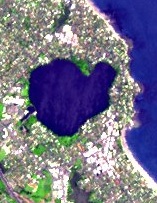 | |
| Rangitoto Island | 0.62 (first eruption) | 260 metres (850 ft) | 36°47′12″S 174°51′36″E / 36.786742°S 174.860115°E | 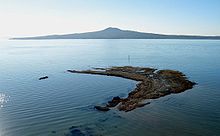 | |
Rarotonga / Mount Smart
|
20.1 ± 0.2 | 87 metres (285 ft) (quarried) | 36°55′6″S 174°48′45″E / 36.91833°S 174.81250°E |  | |
| Styaks Swamp | 19.1 | 16 metres (52 ft) | 36°56′10″S 174°54′01″E / 36.936138°S 174.900155°E |  | |
| Takaroro / Mount Cambria | 42.3 ± 22.0 | 30 metres (98 ft) (quarried) | 36°49′28″S 174°48′07″E / 36.824444°S 174.801933°E |  | |
Takarunga / Mount Victoria
|
34.8 ± 4.0 | 87 metres (285 ft) | 36°49′36″S 174°47′56″E / 36.8266°S 174.7990°E |  | |
Taurere / Taylors Hill
|
30.2 ± 0.2 | 56 metres (184 ft) | 36°51′51″S 174°52′12″E / 36.864223°S 174.869943°E | 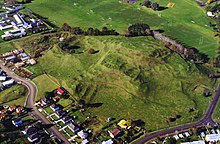 | |
| Te Apunga-o-Tainui / McLennan Hills | 41.3 ± 2.4 | 45 metres (148 ft) (quarried) | 36°55′45″S 174°50′47″E / 36.929208°S 174.846468°E |  | |
| Te Hopua-a-Rangi / Gloucester Park | 31.0 | 12 metres (39 ft) | 36°55′46″S 174°47′05″E / 36.9295°S 174.784734°E |  | |
| Te Kopua Kai-a-Hiku / Panmure Basin | 25.2 ± 1.8 | 35 metres (115 ft) | 36°54′18″S 174°50′58″E / 36.90495°S 174.849343°E | [41] |   |
| Te Kopua-o-Matakamokamo / Tank Farm / Tuff Crater | 181.0 ± 2.0 | 46 metres (151 ft) | 36°48′07″S 174°45′12″E / 36.8020°S 174.7533°E |  | |
| Onepoto | 187.6 | 46 metres (151 ft) | 36°48′29″S 174°45′03″E / 36.80818°S 174.75085°E |  | |
| Te Kōpuke / Tītīkōpuke / Mount St John | 75.3 ± 3.4 | 126 metres (413 ft) | 36°53′00″S 174°46′49″E / 36.883431°S 174.780196°E |   | |
| Te Motu-a-Hiaroa / Puketutu | 29.8 ± 4.4 | 65 metres (213 ft) | 36°57′55″S 174°44′50″E / 36.965186°S 174.747248°E |  | |
| Te Pane-o-Mataaho / Māngere Mountain | 59.0 ± 20.0 | 106 metres (348 ft) | 36°56′59″S 174°46′59″E / 36.9496°S 174.7831°E | [42] |   |
| Te Pou Hawaiki | 28.0+ | 95 metres (312 ft) (quarried) | 36°52′57″S 174°46′00″E / 36.88247°S 174.766726°E |  | |
Te Puke ō Tara / Otara Hill
|
56.5 | 89 metres (292 ft) (quarried) | 36°56′50″S 174°53′54″E / 36.947105°S 174.898363°E |  | |
Te Tātua-a-Riukiuta / Three Kings
|
31.0 ± 1.8 | 133 metres (436 ft) | 36°54′11″S 174°45′17″E / 36.902926°S 174.754651°E |   | |
| Te Tauoma / Purchas Hill | 10.9 ± 0.2 | 50 metres (160 ft) (quarried) | 36°53′14″S 174°50′51″E / 36.887138°S 174.847476°E |  | |
| Waitomokia / Mt Gabriel | 20.3 ± 0.2 | 22 metres (72 ft) (quarried) | 36°58′37″S 174°46′13″E / 36.976981°S 174.770336°E |  | |
| Whakamuhu / Saint Heliers / Glover Park – see Achilles Point | 161.0 ± 36.0 | 65 metres (213 ft) | 36°50′49″S 174°52′04″E / 36.846911°S 174.867662°E | Maungauika / North Head and in the left middle is the tuff crater filled in by the sea of Ōrākei Basin . Beyond Ōrākei Basin in the middle distance are several vegetation covered scoria cones. | |
Wiri Mountain / Matukutūruru
|
30.1–31.0 | 80 metres (260 ft) (quarried) | 37°00′26″S 174°51′30″E / 37.007334°S 174.858441°E | 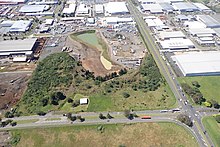 |
See also
- Geology of the Auckland Region
- List of volcanoes in New Zealand
- Volcanism in New Zealand
- Stratigraphy of New Zealand
- South Auckland volcanic field
References
- ^ ISSN 0377-0273.
- ^ a b c d Hayward, Bruce W.; Kenny, Jill A.; Grenfell, Hugh R. (2011). "More volcanoes recognised in Auckland Volcanic Field". Geoscience Society of New Zealand Newsletter (5): 11–16. Retrieved 19 April 2013.
- ^ ISSN 0377-0273.
- ^ doi:10.1130/B31392.1.
- ^ ISBN 978-1-86940-479-6.
- .
- ^ Ian E.M. Smith; Sharon R. Allen (26 January 2010). "Auckland Volcanic Field Geology". Te Pῡ Ao Institute of Geological and Nuclear Sciences. Archived from the original on 9 February 2013. Retrieved 5 January 2023.
- ^ a b c New Zealand Department of Conservation (30 March 2007). "Auckland Volcanic Fields". UNESCO World Heritage Centre. Retrieved 5 January 2023.
- ISSN 0377-0273.
- ^ Hayward, Murdoch, Maitland (2011). pp. 134–135.
- ^ David Lomas (Winter 2006). "Cave New World". Heritage New Zealand. New Zealand Historic Places Trust. Archived from the original on 20 August 2007.
- .
- ^ a b Cronin, S. (2019). Technical Report 6:Geological evaluation Mclaughins Quarry private plan change request Geological evaluation of outstanding natural feature: Matukutūreia and Matukuturua lava field and tuff ring (PDF) (Report). pp. 1–23. Archived from the original (PDF) on 10 February 2024. Retrieved 10 February 2024.
- ^ Kermode, Les (March 1994). "New Zealand lava caves worth preserving for their geologic and geomorphic features" (PDF). Geoscience Reports of Shizuoka University. 20: 15–24. Archived from the original (PDF) on 3 August 2016. Retrieved 6 December 2011.
- ^ Hayward, Murdoch, Maitland (2011). pp. 17–18.
- ^ "Geology". The Onehunga Grotto. 9 May 2008. Retrieved 25 April 2013.
- ^ Hayward, Murdoch, Maitland (2011). pp. 2–3.
- ^ S2CID 128945408.
- ^ Stewart, John R. (26 November 2015). Auckland's buried faults and their influence on its geology (PDF). Geoscience Society of New Zealand Conference (slideshow). Wellington. Retrieved 12 November 2022.
- ^ a b c d Nemeth, Karoly; Kereszturi, Gabor; Agustín-Flores, Javier; Briggs, Roger Michael (February 2012). Field Guide Monogenetic volcanism of the South Auckland and Auckland Volcanic Fields. 4th International Maar Conference. MP131B. Retrieved 2 November 2022.
- S2CID 221380777.
- ^ a b "Mataaho". maori.org.nz. Archived from the original on 1 December 2020. Retrieved 12 September 2021.
- Manukau City Council. Mangere Mountain Education Centre. Archived from the original(PDF) on 24 March 2012. Retrieved 6 October 2021.
- ^ a b "The History of Our Marae". Makaurau Marae. Retrieved 1 September 2021.
- ^ a b Taonui, Rāwiri (10 February 2015). "Tāmaki tribes". Te Ara: The Encyclopedia of New Zealand. Ministry for Culture and Heritage. Retrieved 15 September 2016.
- Wikidata Q58677091.
- ^ a b c d e Tūpuna Maunga o Tāmaki Makaurau Authority (23 June 2016). "Integrated Management Plan" (PDF). Auckland Council. Retrieved 6 October 2021.
- ^ "The volcanic hills are being destroyed..." – City of Fire, insert magazine in The New Zealand Herald, 15 February 2008
- ^ "Ngā Mana Whenua o Tāmaki Makaurau Collective Redress Act 2014 No 52". New Zealand Legislation. April 2022. Retrieved 18 July 2022 – via legislation.govt.nz.
- ^ "Tūpuna Maunga significance and history" [Te Tū whakahira me ngā kōrero tuku iho mō ngā Tūpuna Maunga]. Auckland Council. Retrieved 18 July 2022.
- ^ a b "When the earth starts to shake". City of Fire, insert magazine in The New Zealand Herald, 15 February 2008.
- ^ a b Beca Carter; Hollings & Ferner (2002). "Contingency Plan for the Auckland Volcanic Field" (PDF). Auckland Regional Council. Technical Publication 165. Archived from the original (PDF) on 15 October 2008.
- S2CID 140571635.
- ^ Doherty, Angela Louise (2009). "Blue‐sky eruptions, do they exist? Implications for monitoring New Zealand's volcanoes" (PDF) (Master's thesis). University of Canterbury. Retrieved 7 June 2022.
- ^ "New recorder boosts earthquake, volcano warnings". The New Zealand Herald. New Zealand Press Association. 11 May 2008. Retrieved 22 July 2023.
- ^ "Visit Volcanoes". Auckland War Memorial Museum. Retrieved 28 September 2017.
- S2CID 129707270.
- ISBN 978-1-86940-901-2.
- S2CID 216443777.
- .
- ISBN 978-0-582-71784-8. Retrieved 30 October 2022.
- ^ Mountain, Māngere. "Mangere Mountain History Formation | Mangere Mountain". Māngere Mountain. Retrieved 28 April 2019.
Further reading
- Lava and Strata: A guide to the volcanoes and rock formations of Auckland. Homer, Lloyd; Moore, Phil & Kermode, Les; Landscape Publications and the Institute of Geological and Nuclear Sciences, 2000. ISBN 0-908800-02-9.
- "Probabilistic assessment of future vent locations and eruption styles for the Auckland Volcanic Field, New Zealand". Magill, Christina R; McAneney, K.J.; Proceedings of the International Association for Mathematical Geology 2003, Portsmouth, UK, 7–12 September 2003.
- Volcanic risk ranking for Auckland, New Zealand. I: Methodology and hazard investigation. Magill, Christina R.; Blong, Russell; Bulletin of Volcanology, Volume 67, Issue 4, April 2005, Pages 331 – 339, DOI 10.1007/s00445-004-0374-6, accessed 2006-07-14.
- City of Volcanoes: A geology of Auckland. Searle, Ernest J.; revised by Mayhill, R.D.; Longman Paul, 1981. First published 1964. ISBN 0-582-71784-1.
- "Facies analysis of pyroclastic deposits within basaltic tuff-rings of the Auckland volcanic field, New Zealand (abstract)". Sharon R. Allen, Vivienne F. Bryner, Ian E. M. Smith, Peter F. Ballance, New Zealand Journal of Geology and Geophysics, 1996, Vol. 39: 309–327.
- Volcanoes of Auckland: A Field Guide. Hayward, B.W.; Auckland University Press, 2019, 335 pp. ISBN 0-582-71784-1.
External links
- Volcanic hazards, Auckland Council
- "Auckland field". Global Volcanism Program. Smithsonian Institution.
- "Volcanoes". Auckland War Memorial Museum. Retrieved 28 September 2017.
- Geology: Rocks and minerals, School of Geography, Geology and Environmental Science, University of Auckland (with interactive maps, requiring Apple QuickTime).

